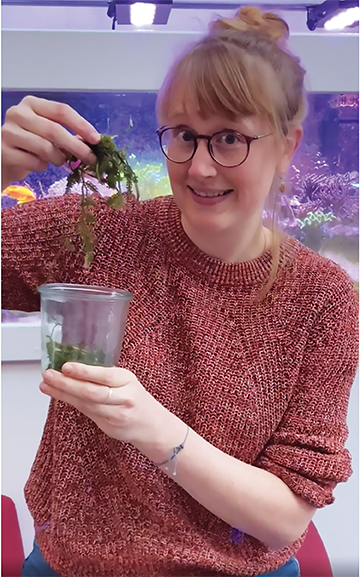
By 2050, the world population of humans is expected to balloon by some twenty percent, to around 10 billion people. What we will all eat is anyone’s guess, but somehow food production needs to keep pace with this growth. The oceans, with their huge and still unexploited potential as a source of food, are increasingly seen as one source of future foods.
Algae are at the bottom of the food chain in the sea, but this means that they can be produced at little expense and very sustainably. A new study by shows how the nutritional quality of algae products can be further improved, using Sea Grapes, Caulerpa lentillifera, a familiar-looking macroalgae from the Indo-Pacific, as an example. (Editor: This species is called “oval sea grapes,” in contrast to the “round sea grapes,” Caulerpa racemosa, most familiar to marine aquarists.) These seaweeds are actually “siphonous macroalgae,” and each plant is a huge single cell that reach 12 inches (30 cm) in length.

Algae have a valuable nutrient profile: few calories, but instead a high content of proteins and unsaturated fatty acids, as well as numerous mineral salts, vitamins, and trace elements. In addition, Sea Grapes, sometimes dubbed “green caviar,” possess a high antioxidant potential. They are characterized by their distinctive form: the little round spheres, which grow from a branch that arises from a creeping stolon with rootlike rhizoids anchoring it to the substrate, taste slightly salty and burst in the mouth like caviar.
“Taste of the Briny Sea”
Sea Grape aquaculture began more or less by chance in the 1950s, when fish farmers in the Philippines found that these algae could grow well in fish ponds. Once established, Caulerpa lentillifera can produce a harvest every two weeks. Nowadays these sea vegetables are also grown in Japan, Vietnam, Taiwan, and China, and they are eaten raw or in salads. The bubbles are said to provide a salty burst in the mouth, said to be “a briny taste of the sea” with definite umami.
However, it is known that harmful free radicals are produced if green algae such as Sea Grapes are exposed to high light radiation. The algae then produce more antioxidants for protection, including vitamins C and E, beta-carotene, and various polyphenols, all substances that make their [MB3] nutrient profile particularly valuable for us. Such antioxidants are essential components of the human diet and are thought to have a positive effect on many human ailments, such as diabetes and cardiovascular diseases. So, could farmers use increased exposure to light radiation to improve the quality of Sea Grapes at a reasonable cost? Lara Stuthmann, marine biologist at the Leibniz Center for Tropical Marine Research (ZMT), in cooperation with the Marine Botany work group at the University of Bremen, lead author of the study, asked herself this question.
For her research she exposed Oval Sea Grapes to five different light intensities for 14 days apiece, after which the antioxidant content was determined photometrically. Doctoral candidate Lara Stuthmann compared the results with various fruits such as Pomegranate and Goji and Aronia berries, which are known for their high levels of antioxidants and hence are regarded as “superfruits.”
In fact, the antioxidant content of Sea Grapes can be more than doubled through targeted irradiation, up to levels such as to those found in pomegranate seeds. Stuthmann says that light irradiation has great potential as a cheap and simple means of increasing the antioxidant content of algae and can be considered for other algae as well. Depending on the level of radiation, however, it can lead to bleaching of the Sea Grapes. Hence the light irradiation and the duration of the treatment should be adjusted depending on the intended use of the algae—in cosmetics or as food, for example.
Algae: Limited Menu Choices
More than 10,000 different species of algae are known, but only eight different genera of algae are being used in more than 90 percent of algae cultures. Many are dried before consumption in order to extract specific molecules such as carrageenan or agar, which are used as gelling and thickening agents. Only a few are suitable for immediate consumption.

According to Dr. Karin Springer of the University of Bremen, a co-author of the study, the special thing about Caulerpa lentillifera, compared to the majority of other macroalgae, is its habit of growth and consistency, which make it a very pleasant experience for the palate. They are easy to propagate and grow quickly. Sea Grapes could find a place on the menu in Western countries, as a source of proteins, antioxidants, and other nutrients.
Sea Grapes could also be suitable for raising in an integrated aquaculture system that combines the cultivation of a variety of animals and plants, creating a natural cycle in which uneaten food and waste products are optimally recycled. In cooperation with algae farms in Vietnam, the ZMT is testing, for example, the co-cultivation of Sea Grapes with shrimps or the sea snail, the Maculated Ivory Whelk, Babylonia aerolata, which is regarded as a delicacy in Vietnam.
—from materials released by ZMT
Reference:
Stuthmann, L. E. R. Achuthan, M. Pribbernow, H. Trung Du, K. Springer & A. Kunzmann (2022): Improving the nutritional value of edible Caulerpa lentillifera (Chlorophyta) using high light intensities. A realistic tool for sea grape farmers. – Algal Research 66 (2022): 102785. https://doi.org/10.1016/j.algal.2022.102785.




